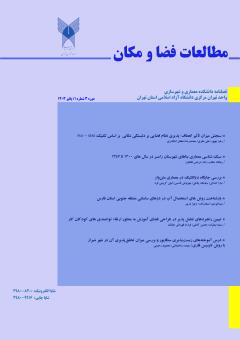درس آموختههای زیستپذیری سنگاپور و بررسی میزان تحققپذیری آن در شهر شیراز با روش تاپسیس فازی
محورهای موضوعی : شهرسازیسعیده ساختمانی 1 * , محمود رحیمی 2
1 -
2 - دانشيار گروه شهرسازي دانشكده معماري و شهرسازي دانشگاه آزاد اسلامي تهران مركزی
کلید واژه: واژگان کلیدی: زیستپذیری شهری, سنگاپور, شهر شیراز, کیفیت شهری, تاپسیس فازی,
چکیده مقاله :
امروزه از یک سو رشد بیرویه شهرها و نبود برنامهریزی و طراحی مناسب در ساخت باغشهرها در حومههای شهر و از سویی دیگر ساخت مجتمعهای مسکونی فشرده باعث تخریب محیط زیست شهری و کاهش زیستپذیری شهری شده است. زیستپذیری شهری یکی از معیارهای اساسی برای سنجش کیفیت زندگی در مناطق شهری است که با ارتقاء آن، میتوان کیفیت زندگی شهری را بهبود بخشید و باعث رضایت شهروندان در زمینههای مختلف شد. این تحقیق با هدف بهرهمندی از درسآموختههای کشور سنگاپور در راستای تحققپذیری زیستپذیری شهری در شهر شیراز پرداخته شده است. سنگاپور علیرغم محدودیتهای زمین به عنوان یکی از قابل زندگیترین و زیستپذیرترین کشورها رتبهبندی شده است. دکتر چئونگ هن (Cheong Koon Hean) به عنوان مدیر عامل هیئت مسکن و توسعه سنگاپور یک مدلی با عنوان تراکم زیستپذیر (livable density) برای طراحی مسکن اجتماعی در سنگاپور ارائه میدهد. در دهههای اخیر باغشهرها پراکنده و مسکنهای اجتماعی فشردهای در شیراز ساخته شده است. از این رو بهرهمندی از مدل تراکم زیستپذیر استفاده شده در سنگاپور جهت تحقق زیستپذیری در شهر شیراز درسآموختهای مفید است. در این تحقیق، از روش تصمیمگیری چندمعیاره تاپسیس فازی برای تحلیل وضعیت زیستپذیری مناطق مختلف شیراز استفاده شده است. ابتدا شاخصهای مختلف زیستپذیری شامل تراکم جمعیت، سرانه فضای سبز، کیفیت آب شناسایی و دادههای مربوط به آن جمعآوری شده است. سپس با استفاده از مدل تاپسیس فازی، فاصله هر منطقه از ایدآل مثبت و منفی محاسبه و رتبهبندی نهایی بر اساس این شاخصها انجام شده است.
Today, on the one hand, the excessive growth of cities and the lack of proper planning and design in the construction of garden cities in the suburbs of the city, and on the other hand, the construction of dense residential complexes have caused the destruction of the urban environment and the reduction of urban livability. Urban livability is one of the basic criteria for measuring the quality of life in urban areas, and by improving it, the quality of urban life can be improved and citizens can be satisfied in various fields. This research aims to benefit from the lessons learned from Singapore in order to achieve urban livability in Shiraz. Despite land constraints, Singapore is ranked as one of the most livable countries. Dr. Cheong Koon Hean, CEO of the Housing and Development Authority of Singapore, presents a model called livable density for social housing design in Singapore. In recent decades, garden cities have been scattered and compact social housing has been built in Shiraz. Therefore, utilizing the livable density model used in Singapore to achieve livability in the city of Shiraz is a useful lesson learned. In this study, the fuzzy TOPSIS multi-criteria decision-making method has been used to analyze the livability status of different regions of Shiraz. First, various livability indicators including population density, green space per capita, and water quality have been identified and related data have been collected.
منابع فارسی
عزیزی، محمد مهدی. (1393)، تراکم در شهرسازی، انتشارات دانشگاه تهران.
سلطانزاده، حسین. (1390)، از خانه تابرج، معماری و راحی داخلی برجهای مسکونی، معماری و فرهنگ شماره 44.
بندرآباد، علیرضا.(1390). شهر زیستپذیر: از مفاهیم تا مصادیق. تهران: انتشارات آذرخش.
پاکزاد، جهانشاه. (1394)، سیر اندیشهها در شهرسازی(2)، انتشارات آرمانشهر.
راجرز، ریچارد، شهرهای پایدار برای سیارهای کوچک، ترجمه خسرو افضلیان (1392)، انتشارات کتابکده کسری.
منابع لاتین
Koon Hean, Cheong (phd), nation – building, Singapore style: better living through density.
Yoon, K. P., & Hwang, C. L. (1995). Multiple attribute decision making: An introduction. Springer.
Evan, R. (2002). Sustainability and livability: Two sides of the same coin. Journal of Urban Planning, 24(2), 98–110.
Evans, J. (2002). Urban sustainability and the role of environmental policy. Urban Studies, 39(5), 1025–1043.
Hedblom, M., et al. (2008). Urban planning and environmental impacts: A review of the global cities. Journal of Environmental Management, 62, 12–23.
Hwang, C. L., & Yoon, K. (1981). Multiple Attribute Decision Making: Methods and Applications. Springer-Verlag.
Ibrahim, M. K., et al. (2002). Urbanization and its effects on public services in developing countries. Environment and Urbanization, 1, 1–16.
National Research Council. (2002). Sustainable Urban Development: The Role of Urbanization in the Environmental and Economic Sustainability of Cities. Washington, DC: National Academy Press.
Yoon, K. P., & Hwang, C. L. (1995). Multiple Attribute Decision Making: An Introduction. Springer-Verlag.

